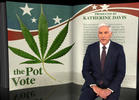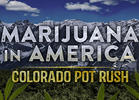
The History Channel has taken a giant step forward with their new four-part, eight-hour documentary mini-series, America’s War on Drugs, which aired from June 18-21.
Part 1 (“Acid, Spies and Secret Experiments”) examines the early rise of LSD use in the U.S., thanks in large part to the CIA and its many nefarious efforts to use acid as a mind-control agent. The episode also examines the rise of heroin production in Laos during the Vietnam War, and the resulting surge of heroin addiction in the U.S.
The remaining episodes focus on the ’80s (Contras and cocaine), the ’90s (heroin and terrorism) and the 21st Century (post 9/11). Among the commentators are former DEA agent Celerino Castillo, former marijuana smuggler and author Richard Stratton, ex-CIA officer Lindsay Moran, former NORML executiuve director Allen St. Pierre, author Doug Valentine and New York University professor Christian Parenti.
Here’s a Q&A I conducted with producer Anthony Lappe about the series:
What is your goal, if you have one, with doing this show?
Our goal was to try and examine the real story behind the War on Drugs. We never realized when we started that, if you truly dig deep enough, you’ll find the story of drugs is really the secret history of the last 50 years—from foreign policy to cultural forces to the economy, drugs have played a central, almost defining role in who we are.
Did all the years of D.A.R.E.-inspired, ONDCP-funded propaganda have anything to do with why you decided to create this documentary?
I think it’s more that we’re living in a time, for better or worse, where a lot of the orthodoxies and power structures are being questioned. It’s not just liberals who are questioning the War on Drugs, so it was more that there was an opening to do something critical. At the same time, we tried not to be dogmatic. We’re not making an argument. We’re telling stories, and through the stories of drug lords and spies and secret experiments it becomes clear that the War on Drugs was really never meant to be won. In fact, drugs have been and continue to be a useful tool for American covert operations.
What have you learned new while doing this show?
I didn’t understand just how central drugs have been to American foreign policy, through the Cold War into the War on Terror—from the CIA-trained anti-Castro Cubans who pioneered South Florida’s drug trade to the creation of the world’s biggest heroin trafficker in our secret war against Communists in Laos to the explosion of cocaine against the backdrop of anti-Communist proxy wars across Latin America to our war in Afghanistan where we empowered and protected the country’s biggest opium growers and traffickers. If you draw a map of all of these insurgencies and counter-insurgencies, they end up overlapping with major drug hotspots. It’s not a coincidence.
What was the most shocking thing you learned?
That the CIA helped the biggest drug lord in South America at the time, Roberto Suarez, take over Bolivia with a team of Nazi mercenaries. That’s just insane. But it happened, and it directly led to the wave of cocaine flooding into the U.S. in the early ’80s.
How do marijuana and the current marijuana legalization movement figure into this story?
We get into marijuana legalization issues in our final episode. One fact that really fascinated me was that the Mexican cartels had heavily been into marijuana until the legalization movement began to spread. As states began to legalize, the Mexicans got more into meth, synthetics and heroin. It shows how adaptable these markets are and how when you crack down or let up on one part of the drug trade, the criminal element will always modify their behavior. The cartels are highly nimble, way more so than a Fortune 500 company. The takeaway is criminal elements want drugs to be criminalized because that’s where their profits lie. So the more you normalize them, the less money the cartels will be able to make, and the less violence you’ll see that comes with it.
Watch the episodes here.






